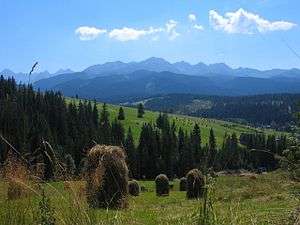Podhale


The Podhale (literally "under the Mountain meadows") is Poland's southernmost region, sometimes referred to as the "Polish highlands". The Podhale is located in the foothills of the Tatra range of the Carpathian mountains, and is characterized by a rich tradition of folklore that is much romanticized in the Polish patriotic imagination. Its folklore was brought there mainly by Polish settlers from the Lesser Poland region further north and partly by Transylvanian settlers in the 14th–17th centuries during their migrations. The name Podhale literally translates as "below the mountain glen" in English.[1] Podhale is a part of the historical province of Lesser Poland (Polish: Małopolska) with its capital in the Royal city of Kraków.
Regional attractions
Among the region's attractions are the popular mountain resort of Zakopane and the lake known as Morskie Oko ("The Eye of the Sea"), which local legend claims, is connected to the Adriatic by subterranean passageways. Nowy Targ along the Dunajec River, located in the valley beneath the Gorce Mountains, is the capital of the region. Ludzmierz is home to the area's oldest shrine, Our Lady of Ludźmierz also known as the Hostess of Podhale or in Polish Gaździna Podhala.
The people in this region are particularly famous for their oscypek, a cheese made from a mix of cow's and sheep's milk, their music, and their ski slopes. In the winter, it is the number one tourist site in Poland.
See also
- Czorsztyn
- Dunajec River Gorge
- Niedzica
- Niedzica Castle
- Pieniny
- Polish Tatra Sheepdog
- Sanctuary of Our Lady of Ludźmierz
- Szczawnica
- Gorals
References
Coordinates: 49°28′45″N 20°01′45″E / 49.479259°N 20.029127°E